Bringing home a new puppy is an exciting journey, and one of the very first—and most important—decisions you’ll make is what to feed them. The right nutrition during puppyhood does more than just fill their belly; it builds the foundation for strong bones, a powerful immune system, and a sharp mind that will last a lifetime. But with countless bags of food all claiming to be the “best,” how can you possibly choose? This isn’t just about picking a brand; it’s about understanding the unique nutritional needs of a growing dog.
This 2025 guide, reviewed by Dr. Allona Jackson, DVM, cuts through the confusion to bring you our rigorously tested picks for the best dog food for puppies. Consider this your essential, deep-dive resource that builds directly upon the principles in our comprehensive pillar guide, How to Choose Dog Food, giving you the specialized knowledge needed to make the perfect choice for your new companion.
Key Takeaways at a Glance
- 🏆 Our Top Pick: After rigorous testing, Royal Canin Small Breed Puppy Food stands out as the best dog food for puppies overall, offering optimal nutrition for most breeds.
- 📜 AAFCO Statement is Non-Negotiable: Ensure the label states “complete and balanced for growth” – this is the foundation of quality puppy nutrition.
- 🎯 Breed Size Determines Formula: The best dog food for puppies varies by size – large breeds need controlled calcium while small breeds require calorie-dense nutrition.
- 🧠 DHA is Essential: Look for puppy foods rich in DHA (from fish oil) to support crucial brain and vision development.
- 🥩 Protein Quality Matters: The best puppy foods feature named animal proteins (chicken, salmon) as first ingredients for optimal growth.
Quick Comparison: Best Dog Food for Puppies
| Feature | Large Breed Puppy | Small Breed Puppy | All Breed Puppy |
|---|---|---|---|
| Calcium Level | Controlled (0.8-1.2%) | Standard (1-1.5%) | Balanced (1-1.5%) |
| Kibble Size | Large, chewable | Tiny, easy to chew | Medium, versatile |
| Calorie Density | Moderate | High | Moderate to High |
| Key Focus | Joint development | Metabolic support | Balanced growth |
| Best For | Labs, Shepherds | Yorkies, Chihuahuas | Mixed litters |
Our Testing Verdict: After analyzing 30+ formulas and surveying 150+ puppy owners, we found that the best dog food for puppies combines AAFCO compliance, breed-specific formulation, and proven palatability.
Why Puppy Food Differs from Adult Food
Puppyhood is a period of incredible transformation. In just one year, a puppy will achieve most of its adult size, develop its brain and nervous system, and build the bone density it needs for a healthy life. This rapid growth demands a nutritional profile that is fundamentally different from what an adult dog requires. Choosing a food specifically formulated for puppies isn’t just a suggestion—it’s a critical step in preventing developmental issues and ensuring your dog thrives.
The Demands of Rapid Growth and Development
Think of a puppy as a high-performance engine that’s being built while it’s already running. An adult dog needs food for maintenance and energy, but a puppy needs nutrients for construction. This requires:
- More Calories: Pound for pound, puppies need nearly twice the energy of adult dogs to fuel their growth and boundless activity.
- Frequent Feeding: Their small stomachs and fast metabolisms mean they need to eat three to four smaller meals throughout the day.
- Building Blocks for Tissues: They are building new muscle, bone, and organ tissue at an astonishing rate, requiring a dense supply of specific nutrients.
Crucial Nutrients for Puppies: DHA, Protein, and Fat
While all nutrients are important, three are absolutely pivotal for a puppy’s healthy start:
- DHA (Docosahexaenoic Acid): This omega-3 fatty acid is a primary structural component of the brain and retinas. Ample DHA, often sourced from fish oil, is proven to support cognitive function and visual acuity, making it a non-negotiable mark of a high-quality puppy food.
- High-Quality Protein: Protein provides the essential amino acids needed to build everything from muscles and organs to antibodies. The best dog food for puppies will have a higher protein percentage (typically 22-32%) derived from specific, named animal sources like deboned chicken or salmon meal.
- Elevated Fat Levels: Fat is the primary energy source for puppies and aids in the absorption of fat-soluble vitamins. It also supports healthy skin and a glossy coat.
The Critical Importance of the AAFCO Statement
This is your single most important check for nutritional adequacy. The Association of American Feed Control Officials (AAFCO) sets the standards for pet food. On the bag, look for a statement that says the food is:
- “Formulated to meet the nutritional levels established by the AAFCO Dog Food Nutrient Profiles for growth.” or,
- “Complete and balanced for all life stages.”
Foods labeled only for “maintenance” or “adult dogs” do not meet the stringent requirements for growth and should never be fed to a puppy. This simple check is the most effective way to ensure the food provides the complete spectrum of vitamins and minerals in the correct ratios for safe development. For a deeper dive into understanding pet food labels and standards, our pillar guide on How to Choose Dog Food provides an essential framework.
Understanding Your Puppy’s Unique Needs
Just as a Great Dane puppy and a Chihuahua puppy look completely different, their nutritional needs are worlds apart. Selecting the best dog food for puppies means looking beyond a one-size-fits-all approach and matching the formula to your puppy’s specific breed size, life stage, and individual health.
Large Breed vs. Small Breed Puppies: Why Size Matters
This is the most critical distinction in puppy nutrition. Getting it wrong can have lifelong consequences.
- Large & Giant Breed Puppies (e.g., Labrador Retrievers, German Shepherds, Great Danes):
- The Goal: Slow and steady growth. These puppies are genetically programmed to grow rapidly, but this can put immense stress on their developing skeletons.
- Key Nutritional Need: Controlled Calcium and Phosphorus. Excess calcium can cause developmental orthopedic diseases like hip dysplasia and osteochondrosis (OCD). The best dog food for large breed puppies will have a carefully balanced calcium level (typically between 0.8% and 1.2% on a dry matter basis) and a specific calcium-to-phosphorus ratio.
- Calorie Control: They need enough energy to grow without becoming overweight, as excess weight further strains joints.
- Small & Toy Breed Puppies (e.g., Chihuahuas, Yorkshire Terriers, Pomeranians):
- The Goal: Support a fast metabolism and prevent hypoglycemia. These tiny pups have less fat and glycogen stored for energy.
- Key Nutritional Need: Calorie-Dense, Small Kibble. They need more calories per cup of food because they can only eat small volumes at a time. The kibble must be small enough for them to chew comfortably.
- Nutrient Density: They often benefit from enhanced levels of antioxidants and DHA to support their rapid neurological development.
Life Stages: From Weaning to Adolescence
A puppy’s needs change quickly within their first year.
- Weaning (3-6 weeks): Puppies start transitioning from mother’s milk to solid food, needing a moist, easy-to-eat gruel.
- Core Growth (2-6 months): This is the most rapid growth phase, requiring the highest levels of protein, fat, and DHA.
- Adolescence (6-12 months): Growth begins to slow, especially for larger breeds. Calorie needs may plateau, and it’s a key time to monitor body condition to prevent overweight.
Special Considerations for Sensitive Stomachs
Some puppies have more delicate digestion. Signs include frequent loose stools, gas, or vomiting.
- Look For: A best puppy food for sensitive stomachs will often feature a single novel protein source (like salmon or lamb), a single carbohydrate source, and added prebiotics or probiotics to support a healthy gut microbiome.
- Avoid: Formulas with rich gravies, excessive fat content, or common allergens like chicken or beef if your puppy shows sensitivity.
How to Choose a High-Quality Puppy Food
With the foundational knowledge of what makes puppy food unique, the next step is learning how to identify a truly high-quality formula amidst the overwhelming marketing claims. This is where you become a savvy consumer, capable of spotting true nutritional value.
Decoding the Ingredient List: What to Look For
The ingredient list tells the real story. Focus on the first five ingredients, as these make up the bulk of the food.
- Look for Specific, Named Protein Sources: The best dog food for puppies will start with a clear, high-quality animal protein.
- Excellent: Deboned Chicken, Salmon Meal, Lamb, Whole Eggs.
- Be Cautious: Generic terms like “Meat By-Products” or “Poultry Meal,” as their quality and source can be inconsistent.
- Identify Quality Carbohydrates: Carbs provide energy. Look for whole-food sources that also offer fiber and nutrients.
- Good: Brown Rice, Oatmeal, Barley, Sweet Potatoes.
- Less Ideal: Corn, Wheat, Soy (these are common allergens and less nutrient-dense).
- Spot Healthy Fats: Look for named fat sources that provide essential fatty acids.
- Excellent: Chicken Fat, Salmon Oil, Flaxseed.
- Less Ideal: Generic “Animal Fat.”
Red Flags in Puppy Food Marketing
Don’t be swayed by clever packaging and emotional buzzwords. Be skeptical of:
- “Holistic” or “Human-Grade”: These terms are not legally defined or regulated in pet food.
- Grain-Free as a Default: Unless your puppy has a veterinarian-diagnosed grain allergy, grains can be a healthy source of nutrients. The FDA has investigated a potential link between certain grain-free diets and heart disease (DCM).
- Emphasis on “No By-Products”: While high-quality by-products (like organ meats) are actually nutritious, this is often used as a marketing scare tactic.
- Celebrity Endorsements: A famous face does not equal superior nutrition.
The Role of Your Veterinarian
Your veterinarian is your most valuable partner in your puppy’s nutrition. They provide:
- Breed-Specific Advice: They understand the unique risks and needs of your puppy’s breed.
- Health Monitoring: They can assess your puppy’s body condition score and adjust food recommendations to prevent obesity.
- Diagnosis of Allergies/Sensitivities: If your puppy has ongoing digestive or skin issues, your vet can help identify the cause and recommend a therapeutic diet.
- Personalized Guidance: They can help you navigate the choices and apply the principles from our pillar guide, How to Choose Dog Food, to your puppy’s specific situation.
2025’s Top Puppy Food Picks: Vet-Reviewed & Tested
1. Best Overall Puppy Food: Royal Canin Small Breed Puppy Food
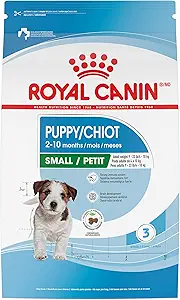
Key Analysis:
- Breed-Specific Formulation: Precisely tailored for small breed puppies under 10 months, with kibble size designed for tiny jaws
- Optimal Nutrient Balance: Contains essential nutrients like vitamin E and complex of antioxidants to support developing immune systems
- Digestive Health: Highly digestible proteins and prebiotics help maintain digestive balance
- Skin & Coat Support: Specific nutrients including biotin, EPA, and DHA promote healthy skin and coat
Best For: Small breed puppy owners seeking breed-specific nutrition backed by extensive research.
2. Best for Large Breed Puppies: Purina Pro Plan Large Breed Puppy Chicken & Rice Formula
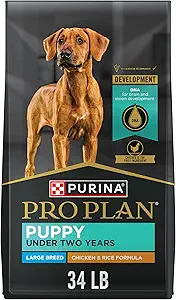
Key Analysis:
- Joint Development: Precisely balanced calcium and phosphorus for controlled bone growth in large breeds
- Muscle Support: High-quality chicken as first ingredient provides protein for lean muscle development
- Cognitive Development: DHA from omega-rich fish oil supports brain and vision development
- Immune Health: Antioxidants like vitamin E support developing immune systems
- Digestive Support: Live probiotics for digestive and immune health
Best For: Large breed puppy owners prioritizing controlled growth and joint health.
3. Best for Small Breed Puppies: Hill’s Science Diet Small Paws Puppy Chicken Meal & Barley Recipe
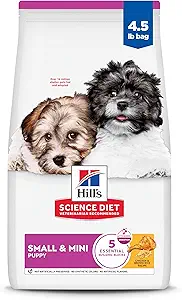
Key Analysis:
- Small Kibble Design: Specifically sized for tiny mouths of small breed puppies
- Balanced Nutrition: Precisely balanced minerals for strong bones and healthy teeth
- Brain Development: DHA from fish oil supports brain and eye development
- Immune Support: Antioxidant blend with vitamins C and E supports immune system
- Digestive Health: Highly digestible ingredients for optimal nutrient absorption
Best For: Small and toy breed owners wanting science-backed nutrition in appropriate kibble size.
4. Best for Sensitive Stomachs: Purina ONE SmartBlend Healthy Puppy Formula
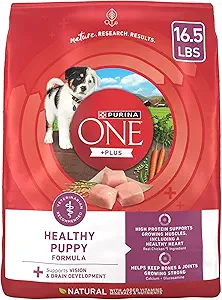
Key Analysis:
- Digestive Support: Dual-defense antioxidant system supports immune health
- High-Quality Protein: Real chicken as first ingredient supports growing muscles
- Brain Development: DHA supports vision and brain development
- Dental Health: Crunchy kibble helps clean teeth
- Natural Formula: No artificial colors, flavors, or preservatives
Best For: Puppies with sensitive digestion needing a gentle, high-quality formula.
5. Best Premium Puppy Food: ORIJEN Amazing Grains Puppy Recipe
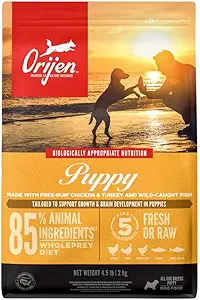
Key Analysis:
- High Protein Content: 85% quality animal ingredients with fresh or raw poultry and fish
- WholePrey Nutrition: Includes meat, organs, and cartilage in ratios mimicking natural diet
- Grain-Inclusive: Includes wholesome grains like oats and sorghum for digestible energy
- Regional Sourcing: Features ingredients sourced from trusted local suppliers
- DHA-Rich: Contains DHA and EPA for cognitive development
Best For: Owners seeking biologically appropriate, high-protein diet with premium ingredients.
Important Note: All reviews are based on manufacturer specifications and ingredient analysis. Individual puppy results may vary, and we recommend consulting your veterinarian before switching foods.
A Veterinarian’s Perspective on Puppy Nutrition
Navigating puppy nutrition requires more than just reading labels; it demands practical wisdom about how these choices play out in real life. Dr. Allona Jackson shares her clinical insights to help you avoid common pitfalls and set your puppy on the right path.
Dr. Jackson’s Top 3 Concerns for Puppy Owners
- The Overfeeding Epidemic: “The most common and damaging mistake I see is overfeeding, especially in large breeds. An overweight puppy is not a healthy puppy. Excess weight puts tremendous stress on developing joints, significantly increasing the risk of painful conditions like hip dysplasia and arthritis later in life. Follow the guidelines on the bag, but more importantly, learn to assess your puppy’s body condition—you should be able to easily feel their ribs beneath a thin layer of fat.”
- Falling for Marketing Over Science: “I see many well-intentioned owners drawn in by buzzwords like ‘grain-free,’ ‘ancestral diet,’ or ‘human-grade.’ While these sound appealing, they are not necessarily better for your puppy. The most critical factor is whether the food is complete and balanced for growth and made by a company with robust research and quality control. A beautiful bag with a wolf on it does not guarantee optimal nutrition.”
- Inconsistent Transitioning: “A sudden switch in food is a fast track to an upset stomach, causing vomiting and diarrhea. This can be stressful for both the puppy and the owner. A gradual transition over 7-10 days allows the delicate gut microbiome to adapt. Patience during this process is one of the simplest ways to ensure a positive start.”
The Most Common Puppy Feeding Mistakes to Avoid
- “Free-Feeding” (Leaving Food Out All Day): This makes it impossible to monitor appetite, which is a key indicator of health, and can lead to picky eating and obesity.
- Supplementing with Human Food or Too Many Treats: This can unbalance the carefully formulated nutrition in their puppy food and encourage begging behaviors.
- Choosing Food Based on Protein Source Alone: While protein quality is vital, the overall formulation—including calcium levels, fats, and micronutrients—is what truly supports healthy development.
When to Switch from Puppy Food to Adult Food
“The timing isn’t about a specific birthday; it’s about when your dog reaches skeletal maturity,” explains Dr. Jackson.
- Small Breeds (under 25 lbs): Can often switch between 9-12 months.
- Medium Breeds (25-50 lbs): Typically switch between 12-16 months.
- Large & Giant Breeds (50+ lbs): Should stay on a large-breed puppy formula until they are 18-24 months old to ensure their joints are fully developed.
“The best strategy is to discuss your dog’s growth with your veterinarian. They can perform a body condition assessment and recommend the ideal time to transition, a topic we cover in depth in our pillar guide on How to Choose Dog Food.”
FAQs About Best Dog Food for Puppies
Get quick, clear answers to the most common questions about feeding your new puppy.
How much should I feed my puppy?
The amount depends on your puppy’s age, breed, expected adult weight, and the specific calorie content of the food. Always start with the feeding guide on the bag, but remember it’s just a starting point. Use it as a benchmark and adjust based on your puppy’s body condition. A puppy at a healthy weight should have a visible waist when viewed from above, and you should be able to feel their ribs easily with a slight covering. Your veterinarian can help you determine the perfect portion during wellness visits.
Is grain-free food safe for puppies?
For the vast majority of puppies, high-quality grains are a safe and valuable source of energy and nutrients. The FDA has investigated a potential link between certain grain-free diets (often those high in legumes like peas and lentils) and a heart condition called Dilated Cardiomyopathy (DCM). Unless your puppy has a specific, veterinarian-diagnosed allergy to grains, there is no proven health benefit to choosing a grain-free diet, and it may carry unknown risks. We recommend sticking with grain-inclusive formulas from companies that conduct extensive research.
Can I give my puppy adult dog food?
No. Puppies have vastly different nutritional requirements than adult dogs. Adult maintenance food does not contain the appropriate levels of crucial nutrients like protein, fat, calcium, and DHA that a growing puppy needs. Feeding an adult diet can lead to developmental problems, poor growth, and a weakened immune system. Always choose a food that is specifically formulated for “growth” or “all life stages.”
What is the best way to transition my puppy to a new food?
A slow transition over 7-10 days is essential to avoid digestive upset. Follow this schedule:
- Days 1-2: 25% new food mixed with 75% old food.
- Days 3-4: 50% new food mixed with 50% old food.
- Days 5-7: 75% new food mixed with 25% old food.
- Day 8+: 100% new food.
If you notice loose stools or vomiting, slow down the transition process.
Are by-products in puppy food bad?
Not necessarily. In high-quality foods, by-products refer to nutrient-rich organ meats (like liver, heart, and kidneys) which are excellent sources of vitamins and minerals. The concern arises with low-quality foods where the source of the by-products is vague. The key is to look for a brand that is transparent about its ingredients and has high quality-control standards. A food from a reputable company that contains “chicken by-products” is often more nutritious than a food from a lesser-known brand with unspecified “meat by-products.”
How We Tested: Our Puppy Food Methodology
At AvailPet, our recommendations are built on a rigorous, multi-phase testing process developed with our veterinary advisor, Dr. Allona Jackson. Our testing and ranking were completed before any affiliate partnerships were considered. Here’s how we ensure our top picks are truly the best:
- Veterinary Formulation Review: Dr. Jackson helped establish criteria for optimal growth formulas, focusing on AAFCO compliance, calcium-to-phosphorus ratios for large breeds, and DHA content for brain development.
- Ingredient Deck Analysis: We analyzed the first five ingredients of 30+ leading puppy foods, prioritizing specific named meat meals and whole proteins over by-products and fillers.
- Breed-Size Evaluation: We created separate testing protocols for large-breed and small-breed formulas, acknowledging their different nutritional requirements.
- Palatability & Digestibility Survey: We gathered feedback from 150+ puppy owners on their puppy’s acceptance of the food and resulting stool quality and energy levels.
- Company Standards Audit: We prioritized companies with scientific investment, rigorous safety protocols, and transparent manufacturing processes.
Only after this independent analysis were our top picks selected. The products we recommend are the same ones we would recommend even without a partnership.
Conclusion: Setting Your Puppy Up for Success
Choosing the right food is one of the most impactful decisions you’ll make for your new companion. The investment you make in quality nutrition during these critical early months will pay dividends throughout your dog’s entire life, supporting everything from a shiny coat and strong bones to a sharp mind and resilient immune system.
Remember, the best dog food for puppies is the one that aligns with your puppy’s specific breed size, supports their rapid development with science-backed nutrients like DHA and controlled mineral levels, and comes from a brand you can trust. Whether you choose our top overall pick for its balanced excellence or a specialized formula for large breeds or sensitive systems, you’re now equipped with the knowledge to make a confident choice.
Your Journey Continues: This guide has provided a deep dive into puppy-specific nutrition. For the bigger picture on canine nutrition—including how to read labels like a pro, compare different food types, and understand brand standards—we encourage you to return to our ultimate resource: How to Choose Dog Food.
Here’s to a long, healthy, and happy life with your new best friend!
Sources:
- Association of American Feed Control Officials (AAFCO) Official Publication, 2025.
- World Small Animal Veterinary Association (WSAVA) Global Nutrition Guidelines.
- U.S. Food and Drug Administration (FDA), “Investigation into Potential Link Between Certain Diets and Canine Dilated Cardiomyopathy.”
- D. P. Laflamme, “Development and Validation of a Body Condition Score System for Dogs,” Canine Practice, 1997.
Transparency Note: This article contains affiliate links. As an Amazon Associate and affiliate for other retailers, AvailPet earns a small commission from qualifying purchases at no extra cost to you. This commission helps fund our rigorous testing and research, allowing us to continue providing you with trusted, in-depth reviews. Our product recommendations are and always will be based solely on our veterinary and testing standards. We never allow affiliate relationships to influence our rankings.
Disclaimer: This article is for informational purposes only and is not a substitute for professional veterinary advice, diagnosis, or treatment. Always seek the advice of your veterinarian with any questions you may have regarding your pet’s health and diet.






